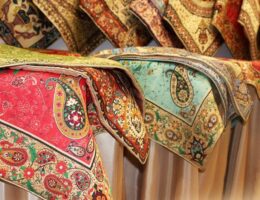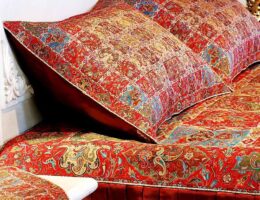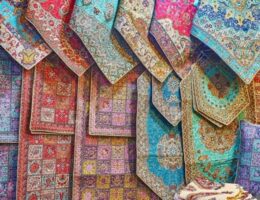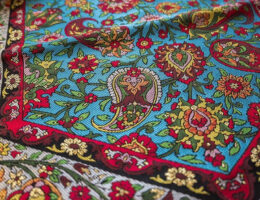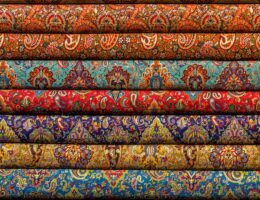IRAN ART EXHIBITION: PICTORIAL CARPET IS A GOOD CHOICE FOR YOUR WALL DECOR
A pictorial carpet, picture carpet, tableau rug, carpet tableau or rug tableau (Persian: تابلو فرش) is an ornamental rug specially prepared for hanging on room and hall walls for decoration. The designs and samples on pictorial carpets are completely different from those on common floor rugs. Pictorial carpets are generally made of silk but they have also been made from wool. Pictorial carpets are usually framed to sell and use.
Description
The very concept and expectations of Persian rugs slowly started to change over the past 25 years. The original tableau rug, also known as pictorial carpet is not known when it was weaved together but some of the old rugs back in 19th & 20th century show that the similar type design were used such as hunting scene in Isfahan or Qum carpet as well as floral design in Isfahan and Tabriz carpet.
Also picturesque scenes from ancient Persia showing the king and his wife is another example. After the 1979 revolution in Iran, the whole industry started to change and many of the original patterns which were famous in Iran were exported to many countries which they have started producing similar products with much lower quality such as China, Turkish, Afghanistan, India etc. and unfortunately selling them in the global market known as Persian design carpets. This have hurt the industry significantly which the export of the Persian rugs has been reducing year by year after the revolution. At the same time a new trend slowly started to take shape as part of the Persian rug culture and Iranian came to a conclusion since they are best known carpet weaver and the oldest known carpet maker in the world & modern society, why not to re-produce some of the most famous, well known and rare art works from across the globe in the new product known as “tableau rug”. What is known is that now this is a new trend in the ancient world of Persian rug.
Pictorial carpets are being woven exactly the same way as the Persian rug has been made over the past 2500 years so there is no different in quality. The main different is that in pictorial carpet, there is not the ancient design and it always has a picture or scenery that are much more colorful with many different scenes. They can be framed the same way as an art work or painting and they are designed to be hung on the wall.
IRAN ART EXHIBITION: The origin and source of hand-made carpets is Sardrood city, one of the major cities of Tabriz To knot a carpet, artists of the city for the first time marketed decorative wall carpets woven from wool and silk. More than 75% of Sardrood, are engaged in this craft. Wall Carpets are known in the name of Pictorial Carpet, Wall Carpet, Tableau rug in the world that has less than 30 years old, and many people like it, and also they are considered as one of the luxury goods and very beautiful for decoration.
The design of wall carpets includes:
1. Rural and natural landscapes
2. The paintings of Iran and world artists
3. The text consists of verses and poetry and literature
4. Flowers and Fruit
5. Animals
6. Portrait
Usually, wall carpets are used with standard Rajshmar 50 or higher for fine texture, and for showing more details, wall carpets usually cover numerous color range, and has a large variety of design. In the past, Carpet actual design of the wall carpet was designed as chessboard and manually painted, and finally printed on paper, which was very difficult and time consuming, with the advancement of science in the field, the maps of Pictorial carpet is made as computer code, and weavers work has become very convenient. However, many people believe that, art is gone in carpet weaving with new technology!
Another advantage of these maps is that, if one doesn’t like to use the ready designs in the market, can give his family photos or personal data to relevant workshops, and it has become a carpet in a short time. How to value Carpets depends on the type of map, Rajshomar, high quality raw materials (yarn quality and transparency of colors), the silk used and dimensions and most importantly the skill of the weaver to knot a carpet correctly. The biggest moquette in Iran, with the words “I love Mohammad”, with 40 languages is woven, the carpet has 21 million knots in 21 meters.
Persian Pictorial Rugs
Persian pictorial rugs are part of a diverse and unique genre that draws inspiration from sources throughout history and daily life. Persian picture carpets exemplify the precision and the capabilities of an art form that has been thousands of years in the making. The pictorial rug is an object of art that captures fantastical hunting scenes, religious icons and snapshots of everyday life. Like other art forms, Persian pictorial rugs include scenes where art imitates life and takes inspiration from other art forms, including music and poetry.
The hunting scene rug and Persian animal pictorials are among the oldest picture carpets. The hunting scene rug represents a sport favored by royalty all over the world. Although rugs featuring humans were often considered taboo for religious reasons, Persian animal pictorials were a suitable replacement that allowed artists to include large numbers of animated figures tucked into a forested background. Persian animal pictorials decorated with lions and symbolic animals were also used to represent power and strength.
IRAN ART EXHIBITION: During the 16th century and the height of the powerful Safavid dynasty, the pictorial rug experienced a surge in popularity as the carpet-commissioning rulers increased their influence over the trade. So-called king carpets depicting royalty became a frequent sight in galleries established by Iran’s leaders. The tradition of immortalizing influential people with carpet portraits continued in the 20th century as Reza Shah and his son Mohammed Reza Pahlevi promoted the trade of carpets and weaving as an art form.
The religious influence that originally prohibited weavers from producing Persian picture carpets eventually led to the creation of Persian religious rugs recounting important events. Persian religious rugs woven in Tabriz, Isfahan and Qom feature an outstanding variety of Islamic, Christian and Judaic scenes.
The outstanding works of Persian Renaissance man Omar Khayyam have inspired generations of carpet weavers and countless Persian picture carpets. Pictorial rugs like those inspired by Omar Khayyam tell stories in an artful manner while depicting historic and imaginary people, places and events.
The Persian pictorial rug has an everlasting and pleasing tactile quality unmatched by other art forms. These diverse rugs encompass a broad range of styles and subjects, including military leaders rendered with photographic precision, whimsical drawings depicting life in Ancient Persia and exotic scenes featuring alluring details. Often woven with fine Kurk wool and silk highlights, these spectacular art pieces are ideal for displaying on the wall.

IRAN ART EXHIBITION: Sardroud is one of the cities of East Azarbaijan province, which is located 8 km southwest of Tabriz and has a population of 35,000 people.
The 3,000-year-old city of Sardroud is considered to be the largest producer of Iranian pictorial carpets, producing more than 85% of Iranian carpets.
At present, about 800 exquisite pictorial carpet production workshops in the city of ‘Sardroud’ are engaged in weaving works of art and exporting them to China, Japan, Germany, and especially the Arab states of the Persian Gulf and southeast Asia, in addition to the domestic market.
Landscapes, animals, flowers, people, faces, compositions, and paintings of world-famous artists are among the most widely used designs of pictorial carpets that have their own fans and Sardroudi weavers present beautiful works according to the tastes and interests of customers.
Sardroud is known as the capital of pictorial carpet weaving in the world, because the art of weaving in Sardroud is unique in the world and there is no competitor for it.
The art of Sardroud pictorial carpet weaving is based on the Lisbon Treaty format and is registered with the World Intellectual Property Organization (WIPO) in Vienna, Austria. The unveiling of this global format took place in the city of Sardroud in 2017.

